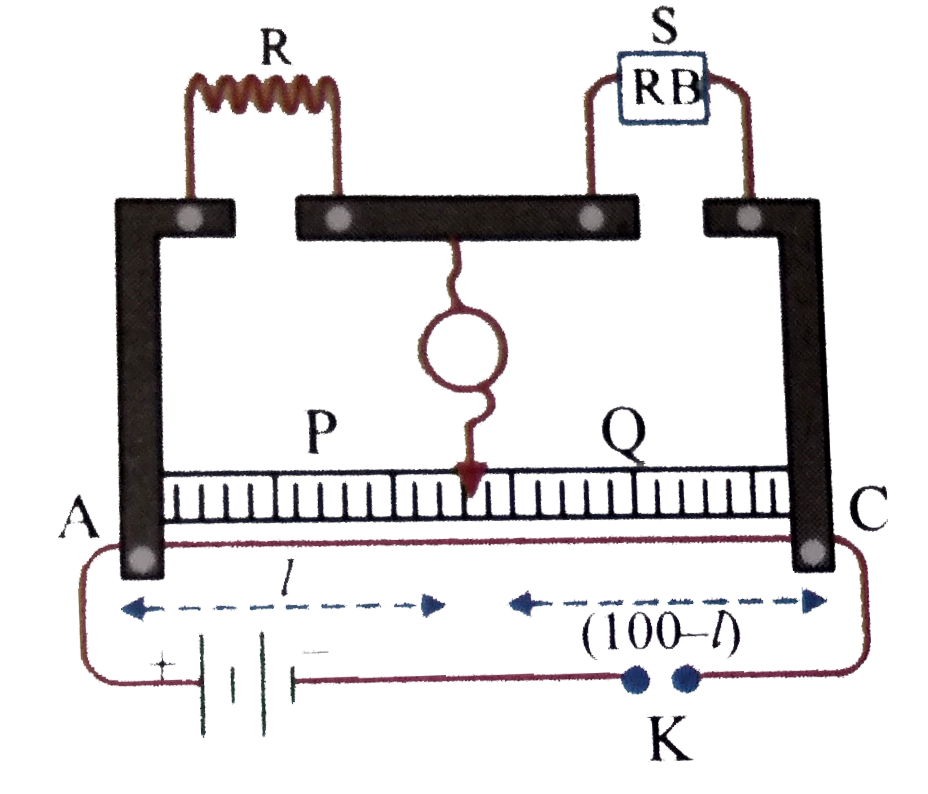A resistance R is to be measured using a meter bridge. Student chooses the standard resistance S to be 100Ω. He finds the null point at l1=2.9cm. He is told to attempt to improve the accuracy. Which of the following is a useful way?
He should measure l1 more accurately.
He should change S to 1000 Q and repeat the \ experiment.
He should change S to 3 Q and repeat the experiment
He should give up hope of a more accurate measurement with a meter bridge.
The correct Answer is:C
The balanced points can be obtained only if the potential difference across the wire is greter than the emf's to be compared (or measured).Therefore, option (b) is correct.
Topper's Solved these Questions
- CURRENT ELECTRICITYBOOK - NCERT FINGERTIPSCHAPTER - CURRENT ELECTRICITYEXERCISE - Assertion And Reason
15 Videos
- CURRENT ELECTRICITYBOOK - NCERT FINGERTIPSCHAPTER - CURRENT ELECTRICITYEXERCISE - Higher Order Thinking Skills
8 Videos
- COMMUNITCATION SYSTEMSBOOK - NCERT FINGERTIPSCHAPTER - COMMUNITCATION SYSTEMSEXERCISE - HOTS
10 Videos
- DUAL NATURE OF RADIATION AND MATTER BOOK - NCERT FINGERTIPSCHAPTER - DUAL NATURE OF RADIATION AND MATTER EXERCISE - Assertion And Reason
15 Videos
Similar Questions
In a meter bridge, null point is 20cm, when the known resistance R is shunted by 10Ω resistance, null point is found to be shifted by 10 cm. Find the unknown resistance X.
View SolutionIn a meter bride, null point is 20cm, when theknown resistence R is shunted by 10Ω resistence, null point is found to be shifted by 10cm . Find the unknown resistence X.
View Solution
Knowledge Check
A resistance R is to be measured using a meter bridge. Student chooses the standared resistance S to be 100Ω. He finds the null point at l1=2.9cm. He is told to attempt to improve the accuracy. Which of the folllowing is a useful way?
AHe should measure l1 more accuratelyBHe should change S to 1000Ω and repeat the experimentCHe should change S to 3Ω and repaeat the experimentDHe should give up hope of a more accurate measurement with a meter bridgeIn a meter bridge, null point is at l=33.7cm, when the resistance S is shunted by 12Ω resitance the null point is found to be shifted by a distance of 18.2cm. The value of unknown resistance R should be
 A13.5ΩB68.8ΩC3.42ΩD1.42Ω
A13.5ΩB68.8ΩC3.42ΩD1.42ΩA 50Ω resistance is connected to a battery of 5 V. A galvanometer of resistance 100Ω is to be used as an ammeter to measure current through the resistance, for this a resistancer rs is connected to the galvanometer. Which of the following connections should be employed if the measured current is within 1% of the current without the ammeter in the circuit?
Ars=0.5Ω in parallel with the galvanometerBrs=0.5Ω in series with the galvanometerCrs=1Ω in series with galvanometerDrs=1Ω in parallel with galvanometer
Resistance of a wire is, measured using a meter bridge and the balancing length for the unknown resistance of 10ω in the right gap is 48 cm. Find the value of the resistance. If the end corrections are 0.6 cm and 0.4 cm respectively for the left and right ends, find the corrected value of the unknown resistance.
View SolutionThe figure shows experimental set up of a meter bridge. When the two unknown resistances X and Y are inserted, the null point D is obtained 40 cm from the end A. When a resistance of 10Ω is connected in series with X, the null point shifts by 10 cm. Find the position of the null point when the 10Ω resistance is instead connected in series with resistance 'Y'. Determine the value of the resistance X and Y

View SolutionIn a meter bridge,

the null points is found at a distance of 33.7 cm from A. If now a resistance of 12Ω is connected in parallel with S, the null point occurs at 51.9 cm. Determine the values of R and S.
View SolutionIn a meter bridge, the null point is found at a distance of 40cm from A. If a resistance of 12Ω in connected in parallel with S the null point occurs at 50.0cm from A Determine the value of R and S

View SolutionIn a meter bridge experiment the resistance to be meausred in connected int the right gap and a known resistance in the left gap has value of 50±0.2Ω when the null points is judged to be at 60±2.0 cm. The students notes is judged to be of the bridge wire are not at 0.0 cn and 100.0 cm of the scale makes ends. The value of the unknown resistance should be expressed as
View Solution
